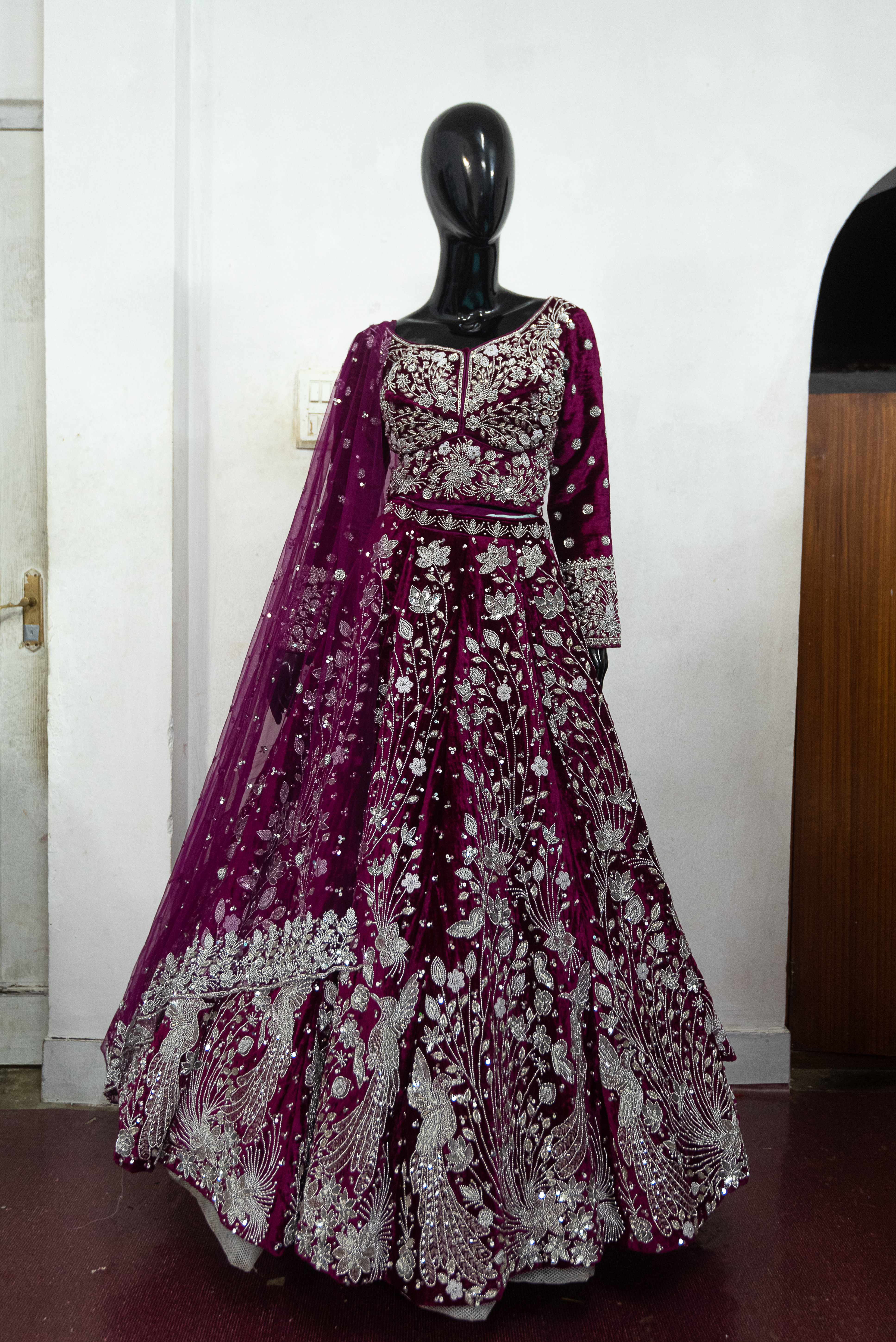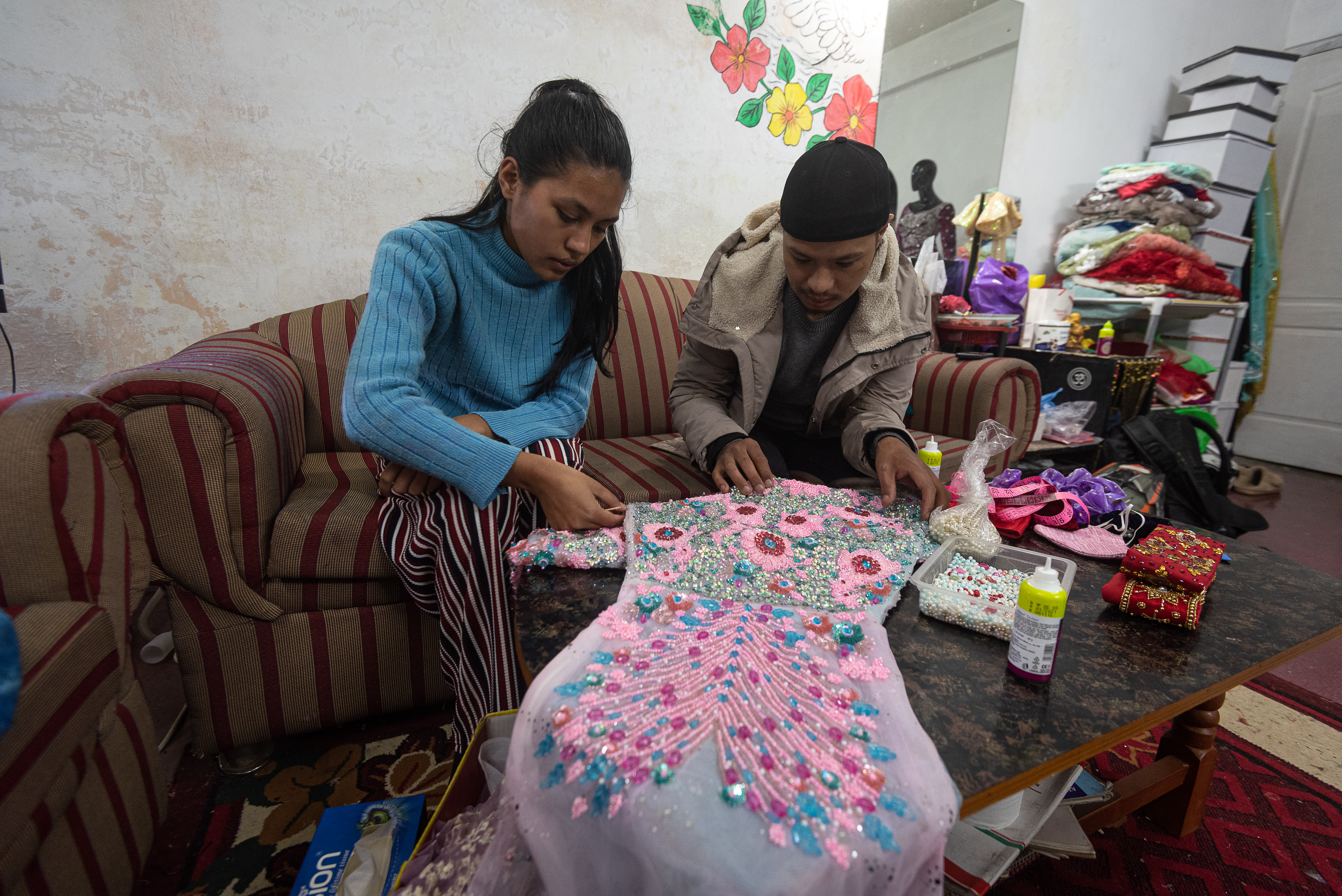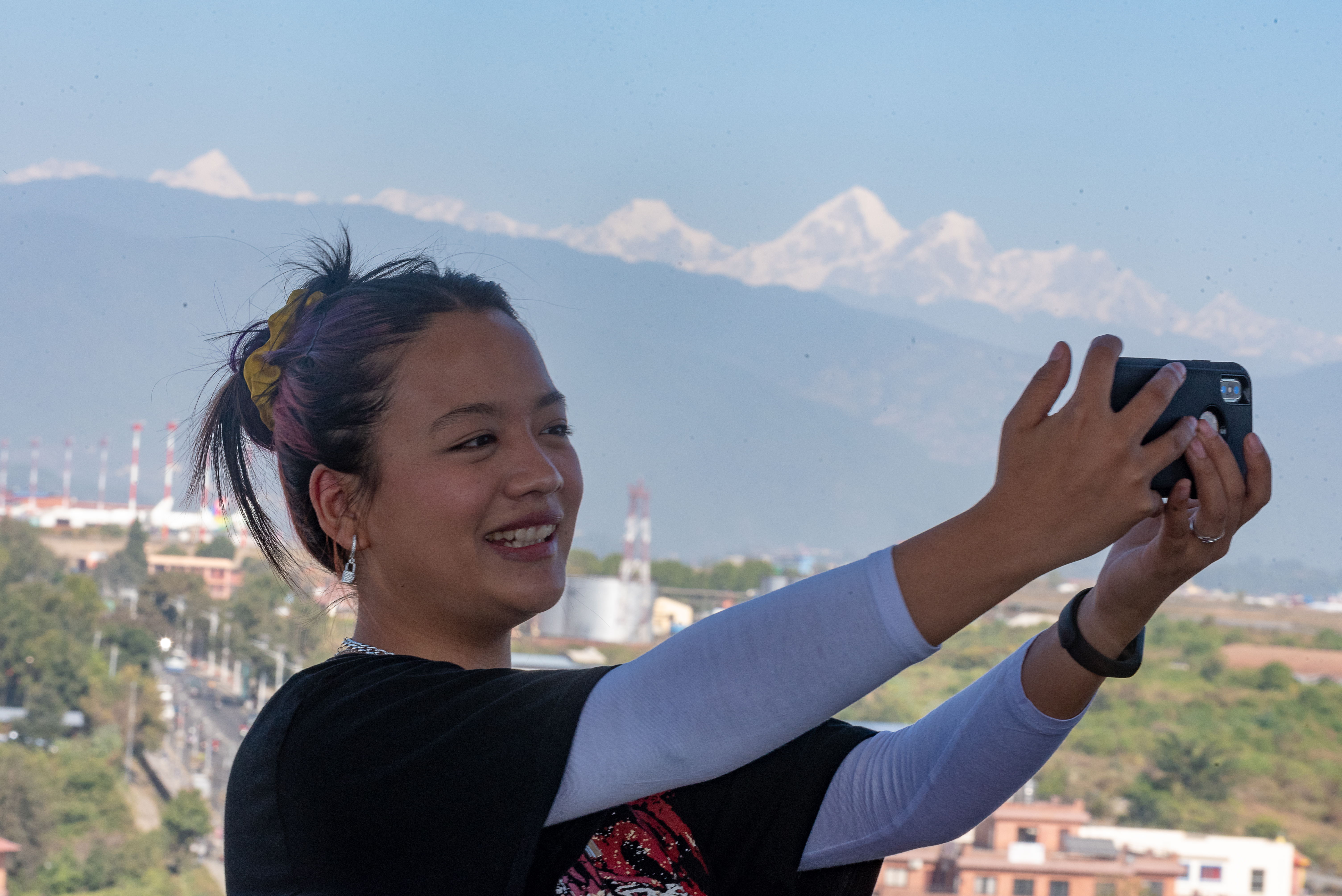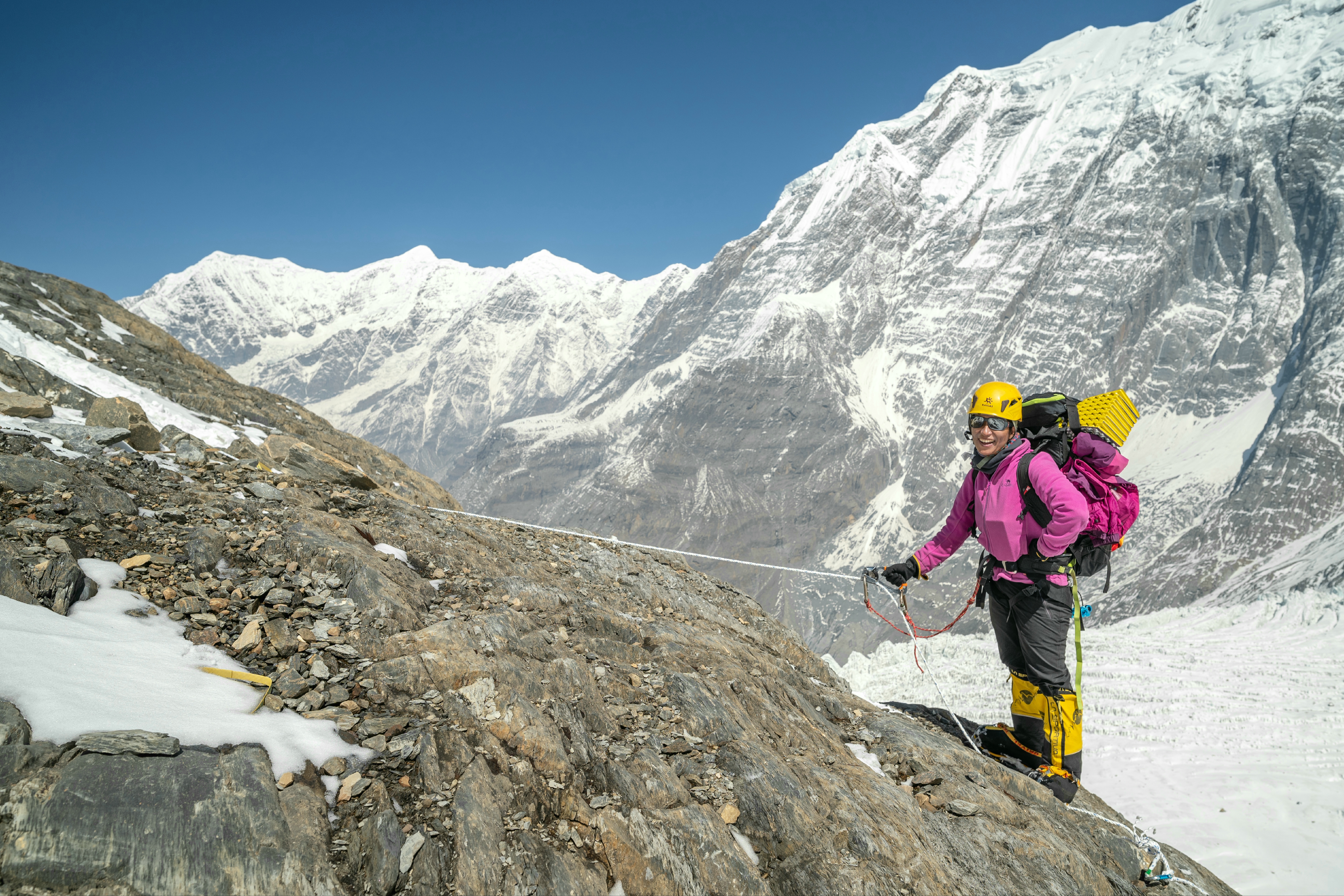Satyajit Pradhan: A worldly musician
Satyajit Pradhan grew up strumming his guitar and singing along to the Beatles on the TV and Narayan Gopal on his parents’ old record player. Born in Lumbini, Nepal, he fell in love with the diversity of musical genres he discovered in different parts of the world.
Pradhan grew up in a musical family. His family moved to the Philippines when he was a toddler and lived there until he was 16. “My parents weren’t musicians, but they were always singing,” he shares. “I was raised in a Nepali household in a foreign country, singing Narayan Gopal and Kishor Kumar songs”.
His high-pitched voice had him singing in choirs as a kid. He discovered he was simply trying to mimic the singing styles of singers and bands he listened to, and in the process, he had learned to sing. Pradhan was introduced to classic Nepali bands at home, and outside, English rock bands fascinated him.
He used to sing with his friends and take part in different singing competitions, in and out of school. In the evenings after school, he found himself listening to the Beatles on the TV for hours. He spent his days daydreaming of one day performing on a concert stage to thousands of people. “I fell in love with the idea of being in a band and with it grew a deep yearning for composing and performing music with my own band someday,” Pradhan says.
Also read: Elena Don: Giving you a reason to smile
At the age of 13, Pradhan started to write his own songs, which were really odes to his overflowing teen emotions. He taught himself to play the guitar and formed his first band. They were a group of friends with a brotherly bond, hanging out, writing songs, and composing, dreaming to take it to bigger concert stages one day.
Soon, they started singing for the people around them. In no time, his music was being admired and appreciated and what started as fun became his passion. “At first, I loved the attention, especially from my girl classmates,” he laughs. “But it slowly grew into this sense of belonging to the stage”.
Pradhan gets the purest form of joy when a new genre of music finds him. In the Philippines, as a teenager, he got into hard rock with a heavy influence of bands like Pearl Jam, Nirvana, and Metallica.
He discovered an entirely new world of music when he moved to the US and started working on a record store called ‘Tower Records’. “As employees, we used to get free merchandise of bands and singers, and everyone rushed to grab the ones by the most popular singers,” he laughs. “I used to be left with the merch by not-so-popular bands”. But that became a blessing in disguise for Pradhan as it opened the doors to experience a whole new range of music.
He found out about local independent artists playing in bands and their incredible music. His journey then became a ride through different genres of music: Latin and Cuban rhythms, classical, jazz, African. “As an empath, every music found a way to move me in ways I couldn’t explain,” he says with joy. “It’s like music resonates with a different part of me and different parts of my life”.
He came back to Nepal—after a spell in England—and met many great musicians and artists. Here, he would form yet another band, Products of Conception, in mid-2020. “We simply played different tunes and I would sing along, and just like magic, we’d be creating songs,” he shared. Products of Conception have so far brought out seven songs for their first album, with 13 more in the pipeline.
Even with a world of experience, Pradhan is a Nepali at heart. “Growing up in a Nepali home out there in the world, I spent so much of my life exploring music from many countries,” he shares. “In the end, I have decided to express myself and my Nepali identity through English songs of the genres I feel the closest to.”
He believes music is his way of communicating. “I often wonder how all of us are one vibration. While singing on stage, watching everyone move and dance to the same beats, banging their heads to the same rhythms, the moment is unreal. I can feel it through my bones and it never fails to bring me closer to the people around me and even closer to myself,” he shares.
These days, he plays music and brings out songs on the side. As a full-time job, he is the director of marketing, communication, evidence, and impact at Marie Stopes Nepal, a company that works on women’s reproductive health.
But he will not stop making music. “I want to tell a story, and I am hoping that my story will make sense to at least one person.”
Sonam Subba Limbu: Design with conscience
Sonam Subba Limbu, a biomedical engineer by training, discovered his love for fashion designing when the products he made during his free time began selling well.
The 28-year-old, now on a mission to build a self-made, environmentally-conscious, and socially-impactful fashion brand, always wanted to do a business that reflected his love for the creative arts.
“I used to work full time at a hospital before,” says Subba. “In the limited free time I had after work, I experimented with designs in my head and if they turned out good, I sold them.”
With his life-long love for designs of all kinds, Subba started stitching by watching Youtube tutorials and experimenting. “I never took any fashion design course—it never crossed my mind,” he says. “What helped me grow was the thought of bringing my designs to life and learning from my mistakes. With every attempt, my love for threads and needles only grew.”

At 25, after getting a wonderful response from his clients—at a time he sold only one or two products a month—he finally decided to upscale. He opened a small studio at Golfutar, Budhanilkantha, and built a team. Then, the pandemic hit.
“Initially, it was a struggle but we kept working and my business started growing as more and more orders started flowing in online,” Subba recalls.
Named after the creator, ‘Sonam Subba Limbu’ is a brand that makes handmade designer wears, focusing on gowns, bridal and occasional wears along with suit and daura suruwal for men.
“When it comes to my designs, my forte is playing around and working with different stones and embroidery,” Subba says. Recently, his team started designing gowns and dresses for beauty pageants. He does the designing and sketching and then works with his team to turn them into garments.
Also read: Can Nepal be self-reliant on flowers? Definitely
Subba intends to build an environmentally conscious business. All the waste produced in the making of garments is recycled to create masks, pouches, hair bands, beads, and latkans. According to the 2020 Preferred Fiber and Materials Market Report, worldwide, only a third of the produced textile fabric gets reused while the rest goes to waste.
Subba is an advocate for zero-waste, as all waste can be recycled one way or the other. The stuff that he cannot recycle are given to factories that turn them into cotton for mattresses. He believes that if every business finds a way to minimize their waste, the overall pollution footprint of companies will be greatly reduced.
He also wants to create part-time opportunities for students. “There are only a few platforms that are student-friendly,” he acknowledges. He trains students, especially those from poor and marginalized families, so they can work to sustain their studies.

With his environmentally-conscious and socially-impactful business, Subba aims to create a ripple effect by inspiring and encouraging other businesses. The customers, too, are more than happy to be a part of a good cause, and the number of returning customers is only increasing.
“Just being engaged in the creative field and advocating what I believe in—I get the energy to keep doing what I do,” Subba says.
He now plans to open a brick-and-mortar outlet. The brand is also looking for more resources and manpower to train more youths. Moreover, he is working to build a platform where garment waste from households can be collected and upcycled.
“If you have a dream of building a business, there are resources, and people are willing to help,” Subba says. “I changed from being a biomedical engineer to a fashion designer. If I can do it, so can you.”
Elena Don: Giving you a reason to smile
How often do you find yourself scrolling through funny Nepali skits that are so relatable to your own life that you just can’t ignore them? If you are one of them, chances are, you have watched one of Elena Don’s comedy-filled short videos.
Twenty-two-year-old Elena Tika Gurung, aka Elena Don, has gone from posting funny skits for her 200 Instagram followers to building a fanbase of more than 84,000 people.
Raised in Buddhanagar, Kathmandu, Elena was the life of her neighborhood, a tomboyish girl who walked around with her cousins beating up bullies. “My friends started calling me ‘Elena Don’ because of my dominating and confident personality,” she laughs. “It has stuck with me since, and, funnily, it became my stage name.”
Her flustered and restless energy has been with her since she was a child, yet Gurung never imagined she would one day become a content creator making funny videos. “I always jumped around from one dream to another, but I did nothing for too long,” she says.
It all started in 2014 when 15-year-old Elena’s love for drama and caricature led her to make short videos for Instagram with the support of her older sister. Little did she know that she would find herself falling in love with the whole process of writing scripts out of her daily life experiences and turning them into videos.
Also read: Saigrace: The ace storyteller
“I discovered there are many people who relate to my videos, creating this unique bond between us,” she confesses. Back then, there were only a handful of female content creators. However, with one new follower after another, eventually, Elena Don soon became somewhat of a household name among young audiences.
Gurung took her content to YouTube in 2016 as she wanted to explore longer formats.
What started as fun has progressed into a process of discovering herself and the causes she believes in.
Gurung likes to take mini-breaks when what she does starts to feel like a chore, yet her creative pursuits always come first in her life. “I genuinely feel happy while making videos and sharing them with those who follow me,” she shares. “My creative process is in my control, and that is empowering”.
Spending so much time on social media came with consequences. As her fame grew, she had to deal with body-shaming and suffer from an eating disorder. This eventually ate into her self-esteem and took a toll on her mental health.
“Looking back, I wish I had someone I could talk to and help me make sense of my anger issues, anxiety and panic attacks,” she shares.

She had grown close to her followers and she opened herself up to the world about what she was struggling with. People consoled her with their own personal stories. Gurung found there were so many like her, desperately looking for a support system to help them cope with their mental health problems.
She wants to create that safe space for people who are lost in their own emotions—just like she had been; and to start difficult conversations about mental mental health. In time, she also wants to pursue a career in psychological counselling.
“It breaks my heart to see so many of us silently suffer,” Gurung adds. “We should be the ones to break that taboo on mental health, for ourselves and for future generations. If I learn and share more on this subject, I feel I can educate and take my followers along as I go.”
With a backpack full of ambitions to use her platform to promote what she stands for, Gurung plans on continuing to make videos even as she pursues formal education.
Despite the ups and downs in her life, she is still inspired by the same reason that motivated her to start making videos to start with: to make people smile. “If a 30-second video can light up someone’s day, why not! I want to give people a reason to be happy.”
Vox Pop | How aware are Nepali youth on climate change?
Nepal, say scientists, is already starting to witness some of the worst effects of climate change, in the form of heavy unseasonal rainfall, rising winter temperature, melting glacial lakes and loss of biodiversity. But how aware are our youths, who make up the bulk of the population, about climate change, and how seriously do they take it? Priyanjali Karn of ApEx talked to 10 of them to find out.
Rupesh Bhattarai, 26, Teacher
I am moderately aware of the effects of climate change on Nepal. As I’m a teacher, I like to keep my students informed, including on climate change, and for that I have to keep up with what is happening and its effects on the people of Nepal. I also follow many scientific communities on social media where I find informed people sharing studies on climate change and its effects on the Himalayan region. Other than that, there’s my own curiosity. For instance, I cannot help but think that the recent spate of floods around the country had something to do with climate change.
Sumana Shakya, 23, Practicing artist
We can compare the experiences of different generations to understand the effects of climate change. Though I don’t know much about it, the recent sudden weather changes cannot be ignored. I remember hearing stories from my grandparents of what Kathmandu city used to be like before urbanization kicked in. There was far less crowding, and there used to be snowfall in Kathmandu, I am told. But our generation has never been able to witness something like that. Perhaps this is due to global warming.

Binod Deuba Thakuri, 21, Climate activist
The climate change narrative is changing and our way of looking at the problem is evolving. Climate change has been affecting our lifestyle for a long time, but we have tended to overlook our role in controlling it. That is the main problem. As a climate change activist, and from what I have seen in my research through Harin Nepal, a youth-led coalition for the environment, our mountains, and glacial lakes are melting, the summers are getting too hot and winters too cold. Yet many government projects continue to fell millions of trees.
Shraddha Shakya, 24, Activation assistant
I am somewhat aware of the effects of climate change in Nepal, but I do not know of it in detail. I read about recent temperature and weather changes in the news. I think the reason many people are not aware of it is because of how little it is discussed among common folks. This is despite the many movements that are working on creating greater climate change awareness.
Hrishabh Karmacharya, 23, Marketing manager
I have a basic understanding of climate change from what I’ve learned through different environment movements and awareness campaigns run by NGOs and INGOs. But I don’t have an in-depth understanding. From what I know, the topic of climate change doesn’t interest many and they tend to normalize it, assuming that they have no part in it. But, evidently, the impact of climate change can already be felt in our daily lives, and all of us play a big or small role in the big picture.
Also read: Nepali Congress boosted by influx of new blood ahead of its general convention
Susmita Aryal, 20, Student of English major
From what I learned as a student, climate change is largely man-made. Earlier this year, we faced the worst air pollution ever, where the valley was covered with smog to a point where it was even dangerous to go out, and it also increased the risk of many diseases. Being an asthma patient, I had to strictly stay at home. I fear there must be hundreds of thousands of other folks like me who have to tough it out. So, yes, I can directly feel the effects of climate change.
Abinish Kumar Dutta, 30, Aerospace engineer
I had been aware of the concept of climate change for a while but I only started understanding its severity in my Bachelors years, although my choice of degree, engineering, was not exactly tailored to increase my climate-awareness. But I had heard about green technologies and wanted to research them out of my own curiosity. On casual observation too, the frequency of natural disasters is increasing. From forest fires, biodiversity destruction, habitat loss to reduced crop harvest, it is only a matter of time climate change will directly and severely affect the daily lives of each and every one of us.
Sumnima Suman, 26, Doctor
I have always been interested in climate change and I keep myself updated on the topic. I studied medicine and climate change was also a part of my dermatology and ENT syllabus. It directly affects the health of children, youth and old people. Climate change increases the risk of illnesses. We see more and more patients who come in because they cannot handle the sudden change of season, which, I suspect, is due to climate change.

Dil Chhetri, 22, Student of Computer applications
It is hard to be oblivious of climate change because it is showing in our lives too. All of us have experienced recent weather changes. But from what I’ve found, there is still a gap between being aware about the topic on the surface and understanding it deep and doing something about it in our daily lives. Climate change news is almost like a rumor: something we like to hear about but then quickly forget.
Pranab Yadav, 29, Operational engineer
I am aware of climate change. There are many factors to gauge its effects. First, the weather pattern is changing on a yearly basis. School curriculum also highlights the issue and I think for most of us, our awareness was built from school. I am an operational engineer and keep myself updated. These days, many news channels are also disseminating news on how climate change affects our country.
Bhairav Prasad Lamsal obituary: The anti-corruption crusader
Birth: 15 June 1940, Kathmandu
Death: 28 October 2021, Kathmandu
A revered name in Nepali judiciary, Bhairav Prasad Lamsal was best known for his strong public stand for the prosecution of around 600 persons, including government officials, judges and politicians—all of whom were shown to own illegal properties by an investigation panel he headed.
Lamsal was born in Kathmandu's Chuchepati, Chabahil. In 1961, aged 21, he entered the judicial service as a public prosecutor. While working in the courts of Nepalgunj, Biratnagar, Janakpur and in other districts, Lamsal started earning a name for his honesty and hard work.
In 1987, he was appointed an additional judge at the Madhyamanchal Chetriya Adalat, paving the way to his becoming the Chief Judge of Nepalgunj Appellate Court on 15 June 1992.
A fearless judge, he stepped into the Supreme Court on 1 August 1997 as a temporary judge; his stay was made permanent on 19 March 1999. He later became an ex-officio member of the Judicial Council and Judicial Service Commission before retiring from the Supreme Court as a judge in 2005. In his decade at the court Lamsal was noted for his judgment based on elaborate reasoning that left no room for any conflict of interest.
Also read: Obituary | Badrinath Shrestha: A thorough democrat
He believed one of the main reasons for the country’s unchecked corruption was the failure of high-ranking state employees to disclose their property details. Inspired by him, in 2002 the then Prime Minister Sher Bahadur Deuba formed the Judicial Commission on Property Inquiry, under Lamsal’s chairmanship.
The Lamsal commission was tasked with combing through property details of almost 42,000 government officials. Among those, the commission found the details of about 600 officials suspicious.
The Lamsal Commission, after working on the report for over a year, handed it over to King Gyanendra in 2003, demanding immediate investigation into the assets of those suspected of engaging in foul play. But the report became a political hot potato, as it was repeatedly passed between the Council of Ministers, the Judicial Council and the Commission for Investigation of Abuse of Authority. (In 2004, the CIAA separately found out that 27 judges at the time owned illegal assets.)
The report brought out the truth of corruption among government officials, politicians and judges and yet no action was taken against them. In fact, the report was never made public.
On 22 July 2005 Lamsal was appointed a legal member of the Judicial Council.
Lamsal passed away on 28 October 2021 at the age of 84. He was suffering from heart problems and later caught pneumonia. He is survived by his wife, two daughters, and a son.
Purnima Shrestha: Passion to climb, urge to click
Thirty-year-old Purnima Shrestha never imagined how beautiful mountains would look up close until she witnessed them herself. Shrestha, who has climbed Manaslu, Everest, and Ama Dablam, is also among the first women to make it to the top of Annapurna and Dhaulagiri.
If someone had told Shrestha in her childhood that she would take up mountaineering one day, she would probably have laughed. None of her family members was into mountaineering and she didn’t live in an area famous for producing mountaineers.
Shrestha grew up in the small town of Aarughat, Gorkha. But her dreams were big. “Ever since I was a kid, I wanted to do something big in life,” she says.
At first, she was attracted to journalism as she liked watching news on television. “I always had a thing for the outdoors,” she says. “I wanted to do something that needed me to go outdoors and explore”.

She discovered that she loved taking photos and telling stories with pictures. So when she learned, a decade ago, that there were only a handful of women photographers in Nepal, she decided to take the plunge.
Her first tryst with mountaineering came when one of her friends who had visited the Everest Base Camp told her stories about the place and the routes. “Just looking at the pictures and listening to her describe it—I started daydreaming about going there one day,” Shrestha says.
Her dream turned into a reality when she got an opportunity to go to the Everest Base Camp with other journalists and photographers in 2017.
Also read: Anish Tamang: Putting his body and soul into it
The artistry of white blankets of snow covering the rocky mountain fascinated her in a way nothing had before then. “Just being there and talking to other mountaineers and guides, I understood the significance of these mountains and felt grateful to be born in a country with such wonders,” she says with a sigh.
But Shrestha wasn’t content with making it to the base camp. She couldn’t stop thinking about climbing higher, and just the thought “gave me an adrenaline rush every time,” she shares. The time had come. Friends and family pitched in and she also got some sponsors on board.
It was September 2017 and she decided to start with the mountain in her home district, Mt Manaslu. “Looking back, the success of making it to the top of Manaslu still makes me happy,” she shares. “I had no training, no experience, just a strong will to do this, and I did it.”
Shrestha craved more adventure and decided to scale Everest this time. Again, she succeeded, in May 2018.

The expedition changed her perspective towards life, as the fearless explorer inside her came out. But her mountaineering adventures were just beginning.
In November 2019, she packed her bags to scale Ama Dablam (6,812m), one of the toughest mountains to climb. “I remember seeing Ama Dablam when I first went to Everest Base Camp,” she says. “There it stood, tall and mighty, with a beauty that follows you as you walk. I was instantly enchanted.”
Though she succeeded, it wasn’t easy. There were so many instances when she wanted to give up. Even though she had to battle death with every step she took, she now looks back at that adventure fondly.
Also read: Souvenir’s Gallery Café: Of delectable cuisines and canvases
“The mountains called me again,” she says, when, in April of 2021, she decided to climb Annapurna, known for being one of the most challenging climbs in the world. No woman had ever made it to the summit until Shrestha overcame it in the company of six other women--Dawa Yangzum Sherpa, Dabuti Sherpa, Pasang Lhamu Sherpa Akita, Maya Sherpa, and Sharmila Sherpa.
Most recently, in September 2021, Shrestha, along with her fellow mountaineer Pasang Lhamu Sherpa Akita, became the first woman to reach the top of Dhaulagiri.
“People don't go to the mountains to die, they go to feel alive, and that's exactly what I wanted to do,” she says.“I also know that the greater the challenges of the climb, the better I will feel at the top.”
As a photographer and mountaineer, she thinks her profession and passion align and propel her to success in every expedition. “On every mountain I’ve summited, the higher I went, the better the view got,” she says. “But no matter how many pictures I took, they could never capture the beauty of the moment that I felt after a tough climb”.
Shrestha wants to climb all mountains in Nepal above 8,000 meters. At one point, she also wants to complete the Great Himalayan Trail, from east to west. She is in constant training and in the process of building up finances for her future expeditions.
Climbing has given her immense confidence. “Just like I have learned to scale big mountains, I am now sure that with some effort I will be able to get over just about any problem in my life,” Shrestha says.
Obituary | Ramesh Maharjan: Gem of a businessman
Birth: 23 November 1964, Lalitpur
Death: 18 October 2021, Lalitpur
Ramesh Maharjan, a renowned businessman who later stepped into social work and politics, believed that underpinning every successful business is creativity.
Maharjan grew up in Lalitpur and completed his schooling at Namuna Machhindra High School, after which he attended Patan Multiple Campus for further studies.
He always had an eye for beautiful gems. So Maharjan spent eight years abroad, learning and exploring the manufacture, refining, and selling of diamonds. When he came back in 1997, he founded RB Diamond Jewelers. At first, it started with a small team and a corner shop at Pako, New Road. In the 24 years since, with his creative mindset and high ambitions, he enlarged his small business into one of Nepal’s biggest sellers of diamonds.
In order to make the ornaments sector a major part of the national economy, in January 2013, Maharjan founded the Federation of Nepal Gold Silver Gem & Jewelry Associations, which was the first national-level organization to facilitate the trading of gold, silver, gems, and jewelry.
As founder and president, Maharjan believed in unity, cooperation, and coordination among businesses.
Also read: Laba Khatri: A footballer through and through
Besides working as executive member and adviser to the International Chamber of Commerce and Nepal Chamber of Commerce, he also served as the chairman of the Nepal Gem and Jewelry Council. Also the President of the Nepal-Sri Lanka Chamber of Commerce, Maharjan was in leadership roles in over a dozen social and business associations.
Maharjan was also an avid social worker. In 2009, he founded Maya Foundation, a non-profit that works with local communities to provide career counseling to youths from marginalized communities. After the 2015 earthquake, through his foundation, he envisioned and led the reconstruction of about 100 houses in Patan under the Newa: Architectural Reconstruction and Tourism Promotion Project.
He later stepped into politics, believing that the current political system was out of date and the country desperately needed a new political set-up. He thus became a founding and central member of the Sajha Party in 2017.
Maharjan tested positive for Covid-19 on October 10 along with his whole family and was later admitted to the Mediciti Hospital in Lalitpur for treatment. He passed away at 11 am on October 18. He is survived by his wife, a son, and two daughters.
Interview | VAT removal could decimate local menstrual hygiene products
Various youth groups have been demanding the revoking of taxes on menstrual hygiene products. Right now, 13 percent VAT is added to the price of menstrual hygiene products in Nepal, where accessibility and affordability of these products are low. Local manufacturers fear the removal of such taxes may flood the market with imported products.
Punit Kumar Sarda, CEO of Sarda Group, the parent company of Nepal’s first menstrual hygiene product manufacturer, Jasmine Hygiene Products, talked to Priyanjali Karn of ApEx on the manufacture and the taxation issues over sanitary products.
Can Nepal’s menstrual hygiene products alone meet local demand?
Yes, the local manufacturers of menstrual hygiene pads can meet the demand of all women and menstruating individuals in Nepal. We don’t need to depend on imported products.
The government hasn’t increased taxes on these products as it acknowledges that menstrual hygiene products are basic needs. The government has also been providing a 95 percent subsidy on raw materials needed to locally manufacture menstrual hygiene products.
Why have the prices of menstrual products been hiked if the VAT hasn’t been increased?
Imported products don't disclose the maximum retail price. That allows retailers and local shops to hike prices as consumers don’t have direct access to manufacturing companies. The companies themselves haven’t increased the prices.
The local manufacturers, however, have to mention the MRP, manufacture date, expiration date, name, and company contact on the packets of menstrual products and it is not easy for retailers to increase prices.
What would happen if the VAT on menstrual products is removed?
If the government revokes VAT, which is paid at the point of sale, the local manufacturers of menstrual hygiene products will be at a loss. They will still need to pay their taxes. But the retailers, on the other hand, will make more profits. This will lead to the downfall of local manufacturers as imported products will then flood the market.
Even if the government removes the VAT, the cost of a packet of pads may come down from Rs 40 to Rs 20, for example. But then we are assuming that those who couldn’t spend Rs 40 will be able to spend Rs 20, which may not be the case.
Also read: What if… sanitary pads were made free?
Why are menstrual hygiene products still branded as luxury items instead of essential items?
Menstrual products aren’t considered luxury products. Everyone knows menstrual products are essential and that is why the government is trying its best to supply them for free in schools and help local manufacturers minimize prices, mainly by supporting import of raw materials.
Why are most Nepali consumers more inclined to imported menstrual hygiene products over local one?
It is a stereotypical belief that products made in Nepal are not as good as imported ones. But if they weren’t good, why would Jasmine Hygiene Products still be selling after 15 years? We sell a product whose quality matches that of imported pads. Like any other company, we do have a price range, starting with the minimum of Rs 40. All products are of good quality and do the job just fine.















